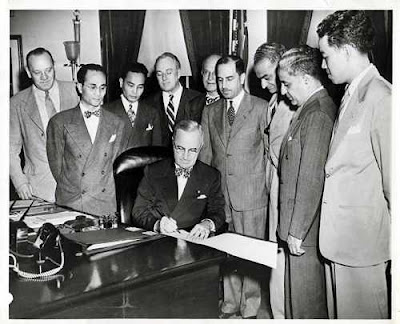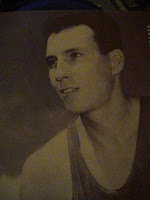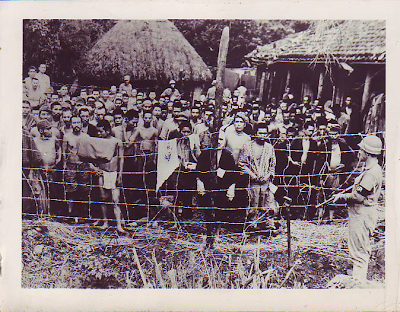
"Bands in the 50s were not called band – they were called combo. A combo was usually a group of singers and musicians, without minimum or maximum number of members, who all contribute their vocal cords and lungs in belting out their numbers and renditions. Having a soloist within the group was the norm. If there was a soloist in a combo, the other members were called pap-pa-ra-rap! Meaning, they were the background vocals. At other times, they were also called chu-wa-ri-wa-ri-wap! --depending on the rhyme and meter of the song."
- "PAP-PA-RA-RAP!" by Dr. Peter Q. Teodoro, Jr.
A new musical genre called Pinoy Rock emerged from this time of newly gained independence from the United States. This was defined as a brand of Rock music that was produced by Filipinos and had Filipino cultural sensibilities. Many Filipinos referred to these Pinoy Rock bands as “combos”, which used nontraditional instruments such maracas, gas tanks, and bongos. During the 1950s, Rock music was gaining popularity internationally through American artists like Elvis Presley, Carl Perkins, Jerry Lee Lewis, and much more. On radio stations in the Philippines, Rock and Roll music was heard continuously especially Elvis’s songs. Many Filipinos imitated his style and covered many of his songs; however, the one who became known as “the Elvis Presley of the Philippines” was the musical sensation and teen idol Eddie Mesa who was the leader of the band called The Trippers.
 Eddie Mesa always loved to sing, but hadn’t heard any of Elvis’s songs until he was in Arellano High School in Pasay. As many other aspiring musicians did, he dropped out of high school and followed his dream. He joined competitions and auditioned for shows such as the dzMB show Oras ng Pananghalian, La Tondeña hosted by Rosa Rosal, and for Don Jose Zarah. He won here and there singing songs by Mario Lanza, Jerry Vale, Vic Damone and Sammy Davis Jr. However, he never attempted to sing Elvis’s songs until he was asked to join a group of brothers who called themselves The Trippers. Eddie explains “the Donato brothers got in touch with me and we formed a band called The Trippers, so called not because we were tripping on drugs but because we always went on trips — to fiestas, funerals, etc.”
Eddie Mesa always loved to sing, but hadn’t heard any of Elvis’s songs until he was in Arellano High School in Pasay. As many other aspiring musicians did, he dropped out of high school and followed his dream. He joined competitions and auditioned for shows such as the dzMB show Oras ng Pananghalian, La Tondeña hosted by Rosa Rosal, and for Don Jose Zarah. He won here and there singing songs by Mario Lanza, Jerry Vale, Vic Damone and Sammy Davis Jr. However, he never attempted to sing Elvis’s songs until he was asked to join a group of brothers who called themselves The Trippers. Eddie explains “the Donato brothers got in touch with me and we formed a band called The Trippers, so called not because we were tripping on drugs but because we always went on trips — to fiestas, funerals, etc.”  He recalls that he auditioned for Don Jose Zarah alone not singing an Elvis Presley song and didn’t get the job because Zarah thought of him as another Bobby Gonzales, who was the other Pinoy Rock icon during that time. However, when Eddie sang an Elvis song with The Trippers they were taken in. Eddie decided that he’d imitate Elvis as much as he can through his vocal style, hair style, and his wardrobe. This is significant because it shows how the imitation of an American pop star is more accepted and favored over the imitation of another Filipino rock star. During this time and throughout history, American brand, music, and culture are what capture Filipinos attention and liking. Towards the end of the 1950s, Eddie Mesa was auditioned to sing in a movie and was given a contract to Premiere Productions where he started not only singing in movies, but also became an actor in many films such as Hawaiian Boy, Aawitan Kita, and Diyes Isang Kanta.
He recalls that he auditioned for Don Jose Zarah alone not singing an Elvis Presley song and didn’t get the job because Zarah thought of him as another Bobby Gonzales, who was the other Pinoy Rock icon during that time. However, when Eddie sang an Elvis song with The Trippers they were taken in. Eddie decided that he’d imitate Elvis as much as he can through his vocal style, hair style, and his wardrobe. This is significant because it shows how the imitation of an American pop star is more accepted and favored over the imitation of another Filipino rock star. During this time and throughout history, American brand, music, and culture are what capture Filipinos attention and liking. Towards the end of the 1950s, Eddie Mesa was auditioned to sing in a movie and was given a contract to Premiere Productions where he started not only singing in movies, but also became an actor in many films such as Hawaiian Boy, Aawitan Kita, and Diyes Isang Kanta. Eddie Mesa along with Bobby Gonzales were the first Pinoy Rock icons. They mirrored American rock style, but Pinoy Rock became a genre of its own as it added its own “Pinoy twist” and is now known internationally. Pinoy Rock started in the 1950s with these legendary icons, continued into the 1970s which became known as the “Golden Age of Pinoy Rock” with the emergence of artists like Freddy Aguilar, and became the music of Filipino protestors in the 1980s such as Aguilar’s song “Bayan Ko”. Pinoy Rock sprung out of a need of a Filipino cultural identity after the Philippines’ independence from the United States; however, this Filipino expression also became an example of the Western influence on the archipelago.

Jailhouse Rock sung by Eddie Mesa
- V Chavez














